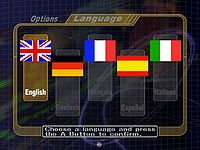User:Monsieur Crow/Language
{{articleIcons|ssbm=yes|ssbb=yes}}
Language is an option found in the Options menu of Super Smash Bros. Melee and the PAL versions of Super Smash Bros. and Super Smash Bros. Brawl. As the name suggests, the player can adjust the language of their copy of the game.
In Super Smash Bros.[edit]
In the European PAL version of SSB64 (uniquely, SSB64 has separate European and Australian PAL versions), the language can be set to English, French or German.
In Super Smash Bros. Melee[edit]
NTSC versions[edit]
In the NTSC versions of Melee, the player can switch between Japanese and American English for their languages. Changing the languages has little to no effect on actual gameplay; almost all changes in the game are cosmetic when languages are switched.
List of differences in the Japanese version versus the American English version[edit]
- Bowser and Jigglypuff are given their Japanese names of "Koopa" and "Purin" in Japanese. All Pokémon, when released, will also say their original names depending on the version.
- The Collection mode will change depending on the language; a list of differences can be seen in the Collection article.
- Trophies will display what console the game was released for in Japanese; this indication doesn't appear in American English. Trophies are also referred to as "Figurines" in Japanese.
- Characters may or may not speak depending on the language. In American English, neither Falco nor Mewtwo speak, but in Japanese, the two speak in full sentences in some cases.
- The platform in the Home-Run Contest is said to be larger when the game is set to Japanese; this has never been verified.
- All distances in the game are recorded in feet in American English, due to America's use of the U.S. Imperial System. All distances are recorded in metres in Japanese, as Japan uses the Metric system.
- The Announcer says different phrases in some of the game modes, which are covered in the Announcer article.
- Crowd chants are different in Japanese than they are in American English.
- The Sound Test features two kanji characters in place of the discs when set to Japanese; these characters also spin when music is played.
- There are various cosmetic changes to the menus. On the Character select screen, for instance, when set to Japanese, the "Ready to Fight!" banner says "Press Start/Pause", while in American English, it will simply say "Press Start". The Lottery also has a green "A" above the lever when the game is set to Japanese.
PAL versions[edit]
In PAL versions of Melee, the player can choose between five different languages in the game, reflecting the multiple areas of the European Union. They are:
- English (Not British English; text is identical to American English.)
- German
- Parisian French
- Castilian Spanish
- Italian
Similar to the NTSC version, changing the language causes some minor changes in the game.
In Super Smash Bros. Brawl[edit]
NSTC Versions[edit]
Players no longer have the option to choose between Japanese and American English in Brawl. The reason for this removal is unknown.
PAL versions[edit]
In PAL versions of Brawl, the player can choose between five different languages, like in Melee. The choices remain the same, and like before, aspects of the game can change. However, the language cannot be changed in-game, as the language for Wii games is decided based on what language the console is set to.

